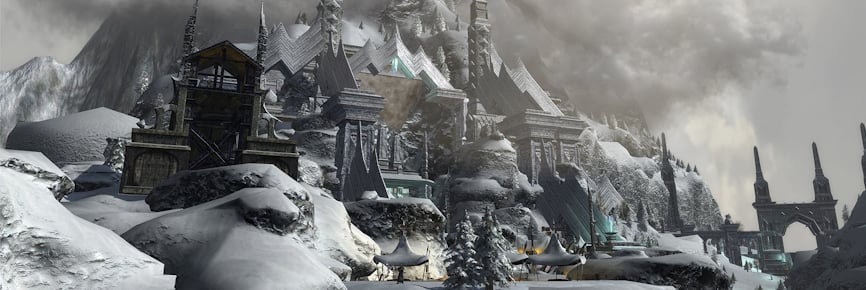LOTRO’s lessons on underground design

In late 2008, Lord of the Rings Online released its first and highly touted expansion, Mines of Moria, featuring the iconic Dwarven underground kingdom (with a balrog and Water or two). For months on end, players surrendered the sunlight to explore vast caverns, mysterious structures, and ancient waterways deep below the surface of the earth.
Around 13 years later, SSG returned to this concept with the launch of Fate of Gundabad, featuring yet another Dwarven underground kingdom. More cognizant of what worked and what didn’t from Moria, the developers made adjustments with Gundabad to avoid pitfalls and problems of subterranean zones that were well-known by now.
It seems to me that LOTRO became somewhat of an expert in the MMO space of creating vast underground regions — something it’s continuing to do with this week’s Update 40. So what lessons can be learned and shared with the wider MMO genre from Moria, Gundabad, and LOTRO’s various other smaller sub-surface areas?

Lesson 1: Underground zones can be incredibly diverse
Just as not every snow zone has to look and feel the same, so it goes for sunken kingdoms. Mines of Moria wasn’t carbon-copy caverns, one after the other; it was a wondrous realm that had been hewn and crafted to the tastes of the Dwarves. Excluding the small external area, this expansion featured an impressive nine zones, each with its own look and theme while fitting into the whole.
There were the expected mines, but also a fiery portion, a waterworks full of pipes and mechanics, giant waterfalls, grand halls, an endless stairway, and nightmarish lakes. The visual language changed as the player worked through the expansion, keeping things from becoming too stale.
With Gundabad, SSG focused even more on diversity — and challenged itself not to create anything that would be too similar to Moria (while still clinging to Dwarven architecture). There’s a zone with impossibly tall scaffolding, a lake cavern featuring basalt columns, a lush garden exposed to the night sky through a crack in the mountain, and a more traditional cave that just so happens to have a city carved into it.
It’s a good reminder that what’s under our feet can be just as wide-ranging and interesting as what we see every day above ground.

Lesson 2: Players (generally) don’t like to be underground for long stretches
Probably the main reason that Mines of Moria developed somewhat of an infamous reputation wasn’t that its zones were bad; it’s that players were effectively “stuck” in Moria for months on end until the devs finally finished work on Lothlorien and let everyone out on the other side. By the time that happened, gamer psyches were scarred by not having seen the virtual sun for a good chunk of the year.
People don’t like not seeing the sky, and that goes for video games as well. We need to bask in nature and feel free of constraints. And if we get bogged down in underground kingdoms, that kind of drives us nuts. In general.
You can see how SSG learned from this in the care it took to make sure that we got frequent recesses from Gundabad’s interior over the course of the expansion. There was even a huge exterior zone plopped right into the middle of the leveling journey, clearly intended to break up the subterranean experience.
Was it enough? Again, your mileage will vary depending on how much these kinds of zones appeal or not to you, but I found Gundabad a lot less claustrophobic in feel than Moria — and I don’t dislike Moria that much.

Lesson 3: Underground zones always come from a disadvantaged position
It’s interesting to me to watch how Blizzard is navigating many of these same design issues with this fall’s The War Within. The studio is clearly aware that it’s more of a liability than a strength to announce a series of underground zones for players to spend the majority of their expansion, so what is it doing? Giving us an external zone for recess and making darn well sure that at least one of those zones is so brightly lit and cheery that it mimics being outside.
Recently, Jeff Libby fielded a complaint about how Update 40 is taking us underneath Umbar. He responded with a humorous observation — “Nobody loves their outdoor environments as much as a LOTRO player does!” — but this interaction illustrates how it’s simply a tall order to create subterranean zones that are interesting enough to overcome the baked-in prejudice that many players seem to have against these regions.
Does that mean MMO developers shouldn’t make them? Not at all! We need as much world diversity as we can get, and exploring mysterious dungeons and caves are part of the very DNA of roleplaying games. But they can be done poorly if the adverse emotions of the community aren’t recognized and addressed. We don’t want to feel trapped, lost, and facing our worst claustrophobic fears when we’re logging in for a fun evening session.
Maybe for some, the dislike of these sorts of places is too great for even the most creative, visually stunning zone to overcome if it’s going to slap a slab of stone overhead.
So how do you feel about underground realms, especially in LOTRO? Are there other lessons you wish SSG would learn from making them?
Comments are closed.

Comments on 'LOTRO’s lessons on underground design' (0)
Comments Feed